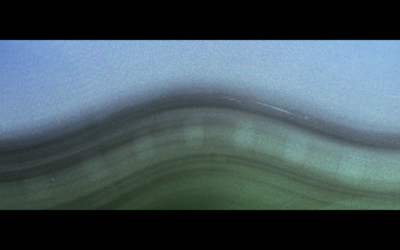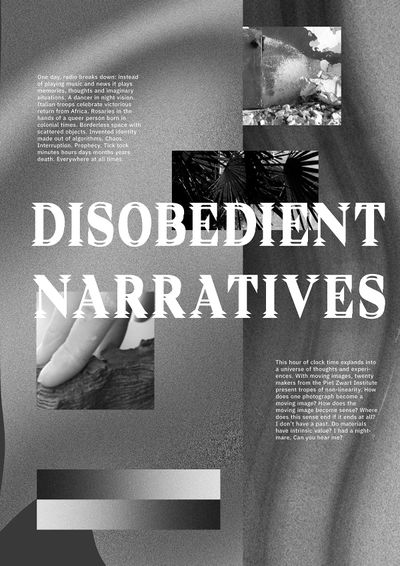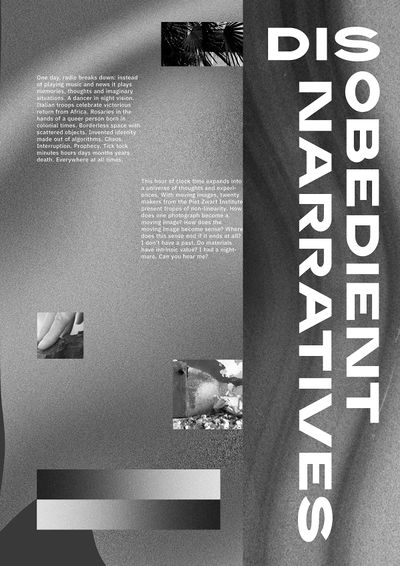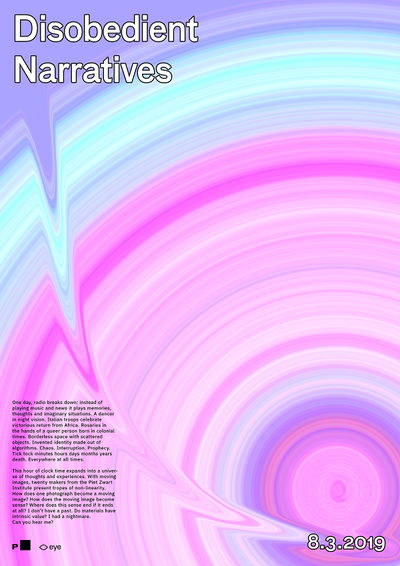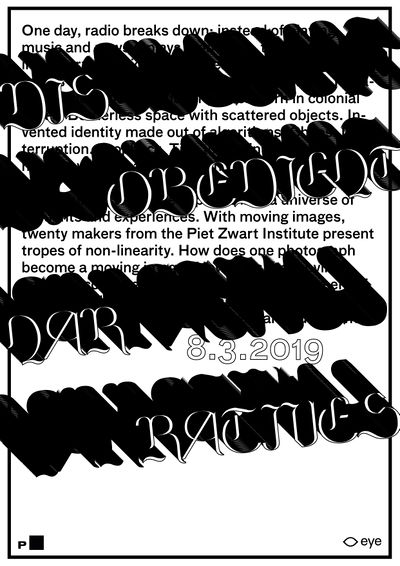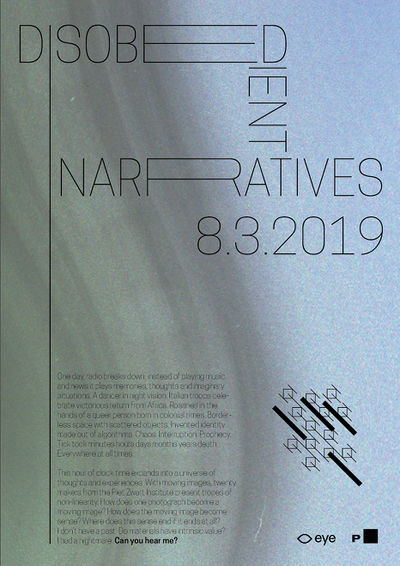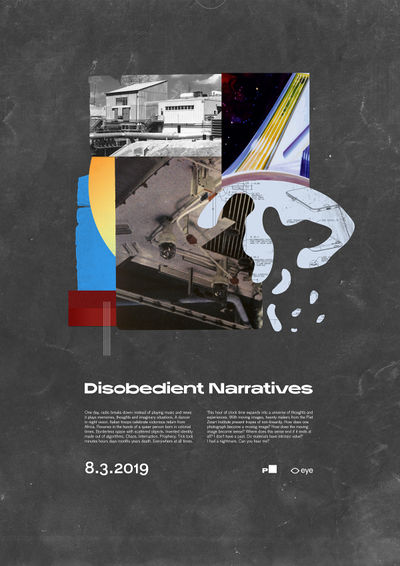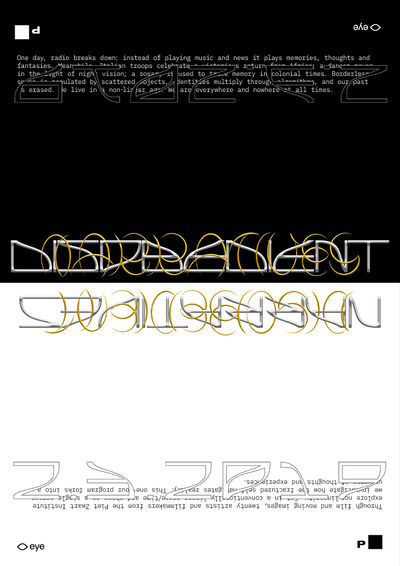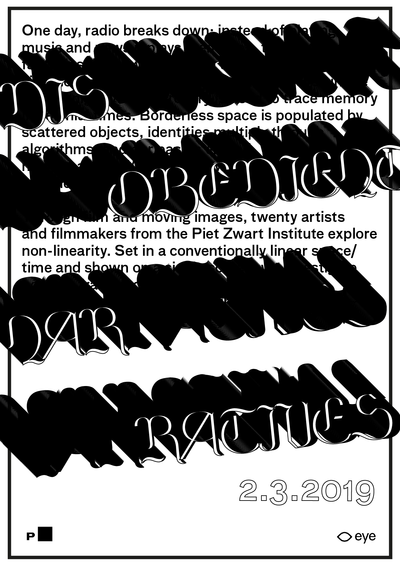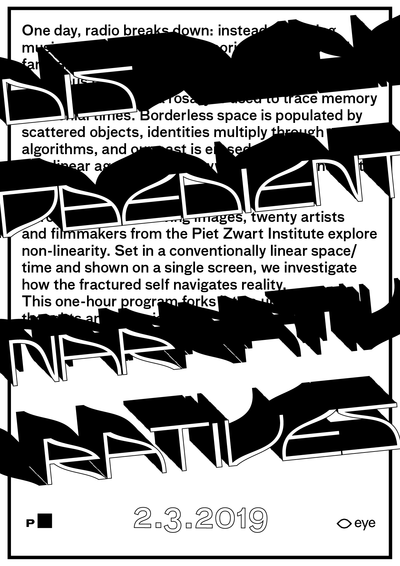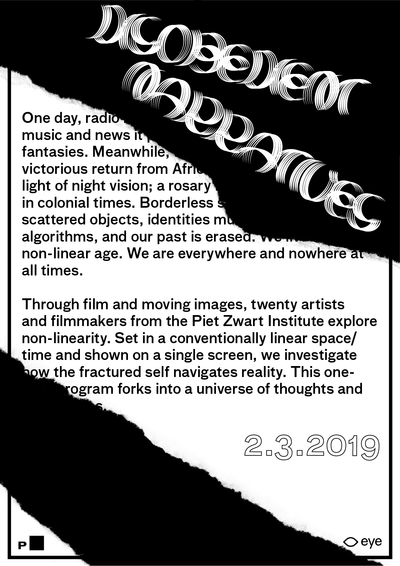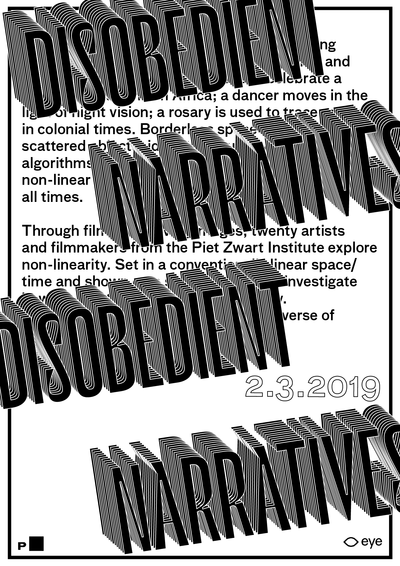EYE Researchlabs
Pad for collaborative notes
https://pad.xpub.nl/p/EYE_RESEARCH_2018-2019
Program
- Sonia
- Marieke
- Zhibin
- Andreas
- Ana Buljan
- Jue
- Katia
- Susanna
- Dorothy
- Mia
- Ugo
- Rossela
- Henrietta
- Felix
- Ana Brumat
- Cem
TICKETS -Sonia +1 -Marieke -Zhibin -Andreas -Ana Buljan (Ana no/Her friend will attend - I will make the swap, Tina) -Jue -Katia -Susanna -Dorothy -Mia -Ugo -Rossela -Henrietta -Felix -Ana Brumat -Cem
Draft for final text
DUE FEB 22.
From the smooth surface of chaos, to the purple hues of desert; from a day at the news stand, to a day of the troop's return; from a poem to a memory to a dream to a failure to recall. A television breaks. A bell rings. A photograph becomes a moving image. What happens? Where will the dark pulses send us? Whose wistful whisper fills our skin with regret?
In this program of sixteen short films, makers from the Piet Zwart Institute interpret non-linearity on the screen. Fragments adhere. Entities emerge. Silence begets curiosity before reality shatters again. As the hour forks into a universe of thoughts and experiences: do we follow the command, or do we shut our eyes?
(from jue: I made the text slightly longer to match the length of the previous blurb. Hope this will help maintain the visual integrity of the program design!)
Nice Jue! (tina) I didn't really change anything of substance, added a word and took out one, & slightly modified a few punctation bits in the first part, as I didn't want to disrupt the flow of thoughts and overall rhythm.
From the smooth surface of chaos, to the purple hues of desert. From a day at a neighbourhood news stand, to a day of the troop's return; a poem to a memory, to a dream to a failure to recall. A television breaks. A bell rings. A photograph becomes a moving image. What happens? Where will the dark pulses send us? Whose wistful whisper fills our skin with regret?
In this program of sixteen short films, makers from the Piet Zwart Institute interpret non-linearity on the screen. Fragments adhere. Entities emerge. Silence begets curiosity before reality shatters again. As the hour forks into a universe of thoughts and experiences: do we follow the command, or do we shut our eyes?
Expanded text + images for EYE (officially due Dec 23)
(edited by Sal and Ewan - we leave both versions up because there's still room for debate on it. We feel the text should be more didactic, rather than as a work of non-linearity itself. The function of a program text is ultimately to explain to the viewer what they will see/themes/etc. rather than engage them in the same rhetorical structure as the works shown. We think the first text may be too non-linear/abstract for a random reader and wanted to hit a middle-ground between didactic and non-linear text.)
Disobedient Narratives
One day, radio breaks down: instead of playing music and news it plays memories, thoughts and fantasies. Meanwhile, Italian troops celebrate a victorious return from Africa; a dancer moves in the light of night vision; a rosary is used to trace memory in colonial times. Borderless space is populated by scattered objects, identities multiply through algorithms, and our past is erased. We live in a non-linear age. We are everywhere and nowhere at all times.
Through film and moving images, twenty artists and filmmakers from the Piet Zwart Institute explore non-linearity. Set in a conventionally linear space/time and shown on a single screen, we investigate how the fractured self navigates reality. This one-hour program forks into a universe of thoughts and experiences.
(edited by Jue)
Disobedient Narratives
One day, radio breaks down: instead of playing music and news it plays memories, thoughts and imaginary situations. A dancer in night vision. Italian troops celebrate victorious return from Africa. Rosaries in the hands of a queer person born in colonial times. Borderless space with scattered objects. Invented identity made out of algorithms. Chaos. Interruption. Prophecy. Tick tock minutes hours days months years death. Everywhere at all times.
This hour of clock time expands into a universe of thoughts and experiences. With moving images, twenty makers from the Piet Zwart Institute present tropes of non-linearity. How does one photograph become a moving image? How does the moving image become sense? Where does this sense end if it ends at all? I don’t have a past. Do materials have intrinsic value? I had a nightmare. Can you hear me?
Image Credit: Jue Yang
Image Credit: Dorothy Cheung
Image Credit: Ugo Petronin
Image Credit: Henrietta Muller
First Poster drafts
Hi altogether, happy new year! I'm still trying out color, typography and grids for the event graphics. Still not very satisfied with my results. But as a sneak peek – here are the very first drafts – these can still change completely:
Also this image developed within the research on how to visualize the event description:
https://www.instagram.com/p/Br-BDIuBJJ-/
But I think this one is focusing too much on analogue media. I'm still playing around with it. Will keep you posted.
Update from 8.1.2019:
Please be aware that the 8.3.2019 is just a placeholder. I have no clue when the event is actually gonna happen.
Update from 2.2.2019:
Final Poster Voting
Update from 14.2.2019:
Log line (please complete before 05/12)
Template
Project name: _____ Maker(s): ________
Logline: ____________________________ (2-3 sentences)
TBD
AnaB
Some messages from the jungle.
Leaving Space
Ugo
35mm film. Scan. Analog. Digital. Immersive. Journey through/within the materiality of film. How one photograph becomes a moving image. Liquidity. Flux.
forgetting time
jue
"I don't have a past." She might have said so, and we might as well believe. In a journey to the mountains, the protagonist finds the cracks, shifts, warps of herself depressed by time measured publicly, tick tock minutes hours days months years death.
interrupted stream
not to appear in the programme as part of its concept
Felix
The screening is interrupted by a failiure of the digital cinema projector. Artefacts of digital video failiure and glitch add in no logical order together into total ridiculousness that obfuscates the actual typicality of the medium and causes confusion of the viewer.
As much as necessary - as less as possible
Andreas
How is the moving image becoming its sense? Where does this sense end? And if it ends, what is beyond this end? This exercise is trying to find the „modest“ or „appropriate“ amount of communication. It shall remove decoration, accessories and digression or even add all these redundancies to find the essence of the disobedient narrative.
(No title yet)
Mia
One day, radio breaks down - Instead of playing music and news it plays memories, thoughts and imaginary situations. This intensifies until it becomes mere noise, just as a vacuum cleaner, sucking imagery and sounds from its surroundings.
No title yet
Marieke
A research to unseen light in the form of night vision narrated by a dancer. Could the use of this light combined with her movements be disobedient in its form?
the banquet
rossella
a convivial image immortalizes italian black shirt troops as they celebrate their victorious return from africa. the reaches of the frame however span beyond the limits of the photograph, weaving together the manifold threads of history.
[TBD]
sal & lotte
A Machine learning program generates a story about a fantastical room built by a bot in this short experimental film that explores the intersection of two artificial worlds.
Neural Network: https://github.com/ryankiros/neural-storyteller?fbclid=IwAR1-4vViUs5cb5Hr-kGRCIu5iHiE48xUvrxN3GifUVXHtkJP_zJ9TbQ2D7Y
Objects: http://roger.redevised.com/#
burning point 0.2
henrietta
I had a nightmare. I was locked in my own house, I could recognise the place, but everything was destroyed. I'm not sure if I'm following someone or I'm being followed by someone. Can you hear me?
Ideas for each film
Make a link to their own EYE page. We can all update our own section as we develop our projects.
Mia: Mia's EYE project
Andreas: Andreas EYE Moodboard
Jue: ojo
Sonia: <⦿>
Marieke: Ideas Eye
Dorothy:Eye_Project:_Rosary
Lotte: EyeEyeEye*2
Ross Eye Banquet
cem eye project
150 words for Thursday 15/11
From pad above
Disobedient Narratives (Working Title)
We live in a non-linear age. We increasingly source our information from social media feeds rather than broadcast. Our interactions are characterised by scrolling through fragmented pieces of time. Our reality shifts between multiple pop-up windows.
Information is overgrown. We crave the condensation: visualizations, synopsis, headlines. We complain about our short attention span while we click subscribe, yet again. We are everywhere at all times.
Non-linear is cinematics, asethetics, politics. In this program - set in a conventionally linear space and shown on a single screen - we investigate how the fractured self encompasses reality.
Collective Research
Add here links to texts/images and any content that relates to the NON LINEAR so that we all have access to it. Each participant will present their research (3 mins max) on Wednesday 14th of November at 18:30.
Dorothy: apology in advance - I probably can't join you in the coming two meetings since my partner is in town, but I would suggest this video in advance, on James Benning - who makes non-linear and actually non-narrative moving images, and in the form of another non-linear essay film. The essay film also recited an interview "James Benning on Time", which might offer some useful quotes / keywords etc.
Chloé Galibert-Laîné and Kevin B. Lee - Reading // Binging // Benning (2018)
https://vimeo.com/252840859
James Benning on Time
https://www.youtube.com/watch?v=bMfuKpUJxPM
Marieke: Here's a list with a couple of non-linear movies: 20 movies with non-linear storyline. I don't really see non-linear only as a way of narration, for me it can also be a disrupted framework of for example a body like these 2 videos by Jesse Kanda: https://www.youtube.com/watch?v=XBxlPZyHQlU https://www.youtube.com/watch?v=a7CTo2-bAA8
Rossella: Some other take on the idea of non-linear as simultaneous accumulation, potentially infinite, of details, but also of story as a sort of endless archive where everything can co-exist at the same time. Famous example in fiction: Funes the memorious, by J.L.Borges: https://marom.net.technion.ac.il/files/2016/07/Funes-the-Memorious.pdf "Funes not only remembered every leaf on every tree of every wood, but even every one of the times he had perceived or imagined it." Borges wrote several meta-fictional texts on this idea of archival infinity. And the already mentioned Foucault's Heterotopias connect more or less with this theme as well: http://web.mit.edu/allanmc/www/foucault1.pdf.
Other approaches that come to mind. Vonnegut's Timequake and, more remarkable and known perhaps, Slaughtehouse-five, which deals with historical trauma and individual experience (the main character witnessing the bombing of Dresden). Non-linearity is defined by Vonnegut as a feeling of coming unstuck in time, perhaps as a way to overcome an unspeakable event: "LISTEN: Billy Pilgrim has come unstuck in time. Billy has gone to sleep a senile widower and awakened on his wedding day. He has walked through a door in 1955 and come out another one in 1941. He has gone back through that door to find himself in 1963. He has seen his birth and death many times, he says, and pays random visits to all the events in between.” Note: I have epub copies of the books, if anybody needs them.
There is a film adaptation of Slaughtehouse-five by George Roy Hill from 1972, but frankly I remember I was not too impressed with it. [Although it is very different from Vonnegut's book and its film adaptation, now that I am thinking about it, Bergman's Wild Strawberries has something in common with both, but it's a much better film overall that George Roy Hill's :P]
A few other examples of non-linearity that came to mind:
New Book, a short film by Zbigniew Rybczyński: https://www.youtube.com/watch?v=ZDem_3xr_3M&t
Here, a comic novel by Richard McGuire: 1 2
Mia:
An example of an animation (also a collaborative work) that deals with non-linear formally but also in terms of content (Three characters, three perspectives, three directors: A session between a psychiatrist, a schizophrenic patient and his mother.), unfortunately only as a trailer Through the Hawthorn - Anna Benner: https://www.youtube.com/watch?v=DnKaO15vgbU
Also Hito Steyerl's work pops up, Liquidity inc. (couldn't find it on internet, but it was in EYE museum last spring), but also other work of hers: https://www.youtube.com/watch?v=LE3RlrVEyuo&t=850s
Un chien Andalou (Luis Buñuel and Salvador Dalí): https://www.youtube.com/watch?v=054OIVlmjUM
movie Manifesto (Julian Rosefeldt): https://www.youtube.com/watch?v=sOA6ramO1aw
Non-linearity made me think of time in literature, for instance how the book Hundred years of solitude (by Gabriel Garcia Marquez) intertwines seemingly chronological time (and stretches it to eternity, timeles cycle) with flashbacks and jumps to future events.
film Manifesto
Films suggested by KABK:
- Last Year at Marienbad (1961) by Alain Resnais
- La Jetée (1962) by Chris Marker
- Stalker (1979) by Andrei Tarkovsky
- Pièce Touchée (1989) by Martin Arnold
- Short Cuts (1993) by Robert Altman
- Magnolia (1999) by Paul Thomas Anderson
- Memento (2000) by Christopher Nolan
Andreas: What is nonlinear warfare? https://www.youtube.com/watch?v=tyop0d30UqQ In this five-minute excerpt Adam curtis depicts the idea of Putin’s advisor Vladislav Surkov to import ideas from conceptual art into the heart of politics.
A very interesting example exploring the question of „whether Tarantino’s choice of using a nonlinear approach to the narrative was just to be cool or if it serves a larger purpose“: https://gointothestory.blcklst.com/nonlinear-storytelling-in-pulp-fiction-bb745c6eeb40
Sonia: Thinking about chaos theory/nonlinear dynamics.
Ana:
>>>Some definitions of non-linear: 'Most systems are inherently nonlinear in nature' //// 'Nonlinear dynamical systems, describing changes in variables over time, may appear chaotic, unpredictable, or counterintuitive, contrasting with much simpler linear systems.' //// 'Chaos – values of a system cannot be predicted indefinitely far into the future, and fluctuations are aperiodic' >>>Chronon: A chronon is a proposed quantum of time, that is, a discrete and indivisible "unit" of time as part of a hypothesis that proposes that time is not continuous. >>>Borges: In "The Garden of Forking Paths", Borges describes a novel by the fictional Chinese scholar Ts'ui Pên, whose plot bifurcates at every point in time. The idea of the flow of time branching can be compared to the many-worlds interpretation of quantum mechanics and the notion of multiverses present in some versions of string theory.[10] Similarly, the infinitude of diverging, infinite universes in mathematical cosmology is reflected Borges' rejection of linear, absolute time.[11] Borges' writings address the nature of entity and the possibility of infinite "realities", as in his essay "New Time Refutations" (1946).[12] >>>from Borges to the Hypertext
Jue
For me what best captures the conceptual difference between linear and non-linear systems is the theory of quantum physics, especially the Copenhagen interpretation. (There are a lot of other theories and interpretations... But that's beyond the scope for now.)
Quantum mechanics does not admit a completely precise description, in terms of both position and momentum, of an initial condition or 'state' (in the classical sense of the word) that would support a precisely deterministic and causal prediction of a final condition.[1]
The metaphors I've used in a past play script include entanglement[2] and the observer effect[3]. (I learned most of these things, and by no means in-depth, by reading wikipedia and watching weeks of PBS Space Time[4]. Yay physics.)
A key pondering from quantum theories is the rejection of determinism and of causality. (Take note: as someone who has no background in theoretical physics, my interpretation/agreement/tendency to include of this interpretation is likely to be under-informed... My favorite evidence is that Einstein disagreed with Bohr, the co-author of the Copenhagen interpretation, believing that causality should exist and is indeed determined by God -- not the religious one, but something akin to nature. [5])
I find discussions on time from Relativity theories inspiring as well. Terms such as proper time[6] and timelike[7] expand the common sense knowledge about the kind of time measurement we are used to (via a clock with hours, minutes and seconds) and a Gregorian calendar. A close reading on linear and non-linear can be a form of intervention: it questions subjectivity, conventions, and frame of reference taken for granted.
Also, digging into some old cartographic knowledge, I find the term linear referencing:
the locations of features are described in terms of measurements along a linear element, from a defined starting point, for example a milestone along a road... Linear referencing is suitable for management of data related to linear features like roads, railways, oil and gas transmission pipelines, power and data transmission lines, and rivers.[8]
This makes me associate linear systems as a way of sense-making and managing the world. So Literatures and thoughts from Enlightenment might be along that line (no pun intended.) And non-linearity in this case can be — stagnancy, uncertainty, intuition, even ignorance??
(There's of course, also scientific definition of a nonlinear system: a system in which the change of the output is not proportional to the change of the input, popular example being chaos theory...[9])
My personal interest in non-linear representations — despite my fascinations in seemingly heady sciences — lies in bodily knowledge and the link, even sameness, between body and mind. Theories of the mind coincide with theories of quantum mechanics... Surprise :)
I find these examples relevant as they showcase:
- the representation of the mind (dissonance, loop, fragments): https://www.youtube.com/watch?v=qLrnkK2YEcE
- a centering experience through magnetic language (the feeling of being here, now, forever): https://www.youtube.com/watch?v=rRNEWuclgrs
- "in a sense all places is the same place": https://www.youtube.com/watch?v=wD68PZ0AR5o
Susanna
What's more non-linear than dots? Yayoi Kusama
If I think about the non linear as equal to a dot or a point and try to relate it to narrative I think about Gregory Crewdson's photographs. They tell a story that doesn't have a traditional narrative, the story only has the one moment that is happening in the photo.
Cem
flow of consciousness - dreaming - automatic writing - trauma - remembering https://www.youtube.com/watch?v=hu9L5zQ4g0Q from 1:52 to 5:28
the flow of consciousness (mostly in literature) is a way of expressing a character’s thought process, as we never think in straight lines, its a chaotic flash of thoughts. the neurons in our brain form a complex network that transmit what we name as thoughts, images. when we think of something, in the act of remembering, it is not a linear understanding of a story, but we get bits and pieces that we create a whole from. when we are dreaming, we delve into our memories. our brain is partially highly active in areas like amygdala and hippocampus but low on prefrontal cortex which is plays an important role with logical thinking and self control which makes our dreams appear as a series of events that does not make any sense.
Katia
A form where language is not linear is poetry, if we think that non linear has to do with how concepts are arranged. In the linear language we are used to, if you want to make a point, or tell a story, or teach a skill, you need to control the sequence in which the target receives information. In poetic language you cannot control that. By emphasizing the illusionary nature of the relationship between linguistic and non-linguistic signs a multiplicity of potential meanings is achieved within the poem. "The Color of Pomegranates"
Meetings
5.12. 2018
18 PARTICIPANTS IN TOTAL
Do we meet before the holiday? Probably not, BUT we can send Tina our progress and get feedback individually...
Deadlines:
- questions for the EYE (via Susanna): 10.12.!!
- LOGLINES until 10.12.!! Also we need more pictures (anyone who already has any images/stills etc from your work, please send them to Susanna, Mia or Jue)
- 300 word text from the loglines by 14.12. (SAL will take over Jue's text in case something has to be changed)
- Andreas makes a draft for poster/brochure by the end of the year
- Deadline Sunday 6th January - MAJOR UPDATES (Tina giving us feedback individually, also Skype is possible etc.)
Duration of each film should be between 2-5 min
14.11.2018
MEETING 14.11. 2018 - RESEARCH SO FAR
PRESENTATIONS:
Susanna: dots (opposed to lines, rather literal aspect), points as narrative – that only take a moment in time, photographical representation of a dot
Ana: hypertext, cutting the story and rearrangeing it in a different (random?) order
Felix: making a linear work first an afterwards disrupting it to make it non-linear
Marieke: connacted to shape, nonlinear shape of the body
Cem: chaotic images, thoughts, flow of consciousness, automatic writing (as a method for a script, examples such a s James Joyce...)
Andreas: nonlinear warfare
Ugo: why nonlinear, why it's important - tool to capture human experience, to approach identity, denial of idedntity ('we have to be linear'), how do we unlearn from linearity, is linternet linear/nonlinear, domination system (politics), not just the narrative trick, films, expresiion 'to go nonlinear', Gilles Deleuze, Fernand Braudel, hyperlink cinema
Henrietta: Dali, Lacan, delirius phenomenon, dreams
Jue: quantum mechanics, conceptually captures the difference between linear-nonlinear, same interest as Cem (bodily knowledge, body-mind, mind is a big component), mad person's mind (fragments, dissonance, loop), a poem
Sonia: related to Ana, chaos, dynamics, non-linear, outside of narrative
Rosella, Sal: Borges, remembering, injured guy, remembering every instance, about every man being every possible man at the same time, all possible universes Mr. Nobody (film), to recall all his past calls
Ewan: The Mirror (Tarkovsky), cinema poem about childhood, relationships memories; 2 layers (hand holding a card, where another film is happening) Dorothy:
THE TEXT - useful for the longer version: time, memory, subconsiousness, parallel realities, identities, some other keyword to be added in teh text .... hypertext, random access, database, kairos, achrony, temporal (dis)order, chaos... in media res, lucid dream, ellipsis, :)
WORKING TITLE: Disobedient Narratives
12.11.2018
After voting on the above we decided on: Films will be non-linear (broadly-interpreted)
A short blurb of 150 words and at least 1 image is due THURSDAY 15/11/18. Please add relevant keywords/phrases to the pad.
Next meeting: Wed 14/11/18 @6:30pm in studio, preferably with 2-mins presentation of research on "non-linear." In the meeting we will decide on: images to use for the blurb and potential collaborations.
05.11.2018
Met about how to proceed with the theme.
Decided on:
DELIVERY ROLES
• WRITER : Jue Writes about our theme. Descriptions (short description and blog longer description)
• THE EYE CONTACT : Susanna Someone to liaise with The Eye & collect information from everyone.
• TECHNICAL PERSON: Ugo Technical issues, checking files for any errors a week before and compiles Technical Rider for the Eye.
• MARKETING MATERIALS/DESIGN: Andy e.g. poster, program, etc
• DEADLINE PERSON (A.K.A. BALL BUSTER): Mia Gives reminders for set deadlines, “Don’t forget to…” emails, etc.
Next actions:
meet to decide on the process/consistency of content before next time we meet with Tina (12/11/18)
BEFORE NEXT MEETING (12/11), PLEASE PREPARE THE FOLLOWING
1. On the pad, write down your name and your suggested method for all of us to generate ideas. Here is an examples from today’s meeting.
- "I will bring in today's newspaper. We can then choose a piece of interesting news from that day and use that as the start for our film, however we are inspired." (idea credit: Ugo)
2. In the pre-meeting at 17.00, we will discuss/vote on the idea we’d like to go forward with. Depending on the scope of the idea, we might be able to develop our collaboration plan or elaborate our derived idea -- if not, at least we can take concrete actions and sum them up for Tina.
29.10.2018
LB: 17:30 - ±19:00 EYE Meeting with Simon and Tina Bastajian in the large project space
- Tina Bastajian is a Los Angeles born, Amsterdam based media artist, researcher, essayist, and educator. Her work uses experimental approaches to documentary forms to explore
themes of memory, displacement, palimpsest, and the contours of voice and translation. These impulses also coalesce with her artistic research into moving image heritage and (counter) archival constellations and dramaturgies which include interactive documentary, expanded cinema, found-footage practices, and location-based storytelling. Tina currently teaches documentary film studies at Amsterdam University College (AUC) and is an essay tutor at the Sandberg Instituut, Masters of Art and Design program. She has also been a visiting artist/tutor at the Royal Academy of Art (KABK), the Dutch Art Institute and Piet Zwart Institute. Her work has been shown internationally from the Beirut International Film Festival to the Centre for Oral History and Digital Storytelling (Montreal).
25.09.2018
Our first engagement with the EYE Researchlabs will take place in Eye already on the 25th of September.
At 16.30 in the cinema 2 we will give a short introduction of the project to the students, followed by a speed date encounter in the Ijlounge (an Eye space) during which students will have chance to meet each other more closely.
At around 18.30 the students are invited to visit the exhibition of Ryoji Ikeda with a guided visit by Claartje Opdam, the project manager exhibitions in Eye.
Deadlines
- November 15: Short topic description (150 words) + at least one photo.
- November 30: decisions on commitment, collaboration and the number of films; short blurb for each project (individual or collaborative)
- December 10:
- questions for the EYE (via Susanna): 10.12.!!
- LOGLINES until 10.12.!! Also we need more pictures (anyone who already has any images/stills etc from your work, please send them to Susanna, Mia or Jue)
- 300 word text from the loglines by 14.12. (SAL will take over Jue's text in case something has to be changed)
- December 23:
- Request of digital and analogue films from Eye and from other distributors.
- Longer text (300 words) and more photos for the final Eye web page.
- January 6: MAJOR UPDATES (Tina giving us feedback individually, also Skype is possible etc.)
- January 25: Program, production, technique info (technical rider).
- February 1:
- AV content delivery (video files, slides, prints).
- List of participants in your project (to arrange free tickets on March 2nd).



